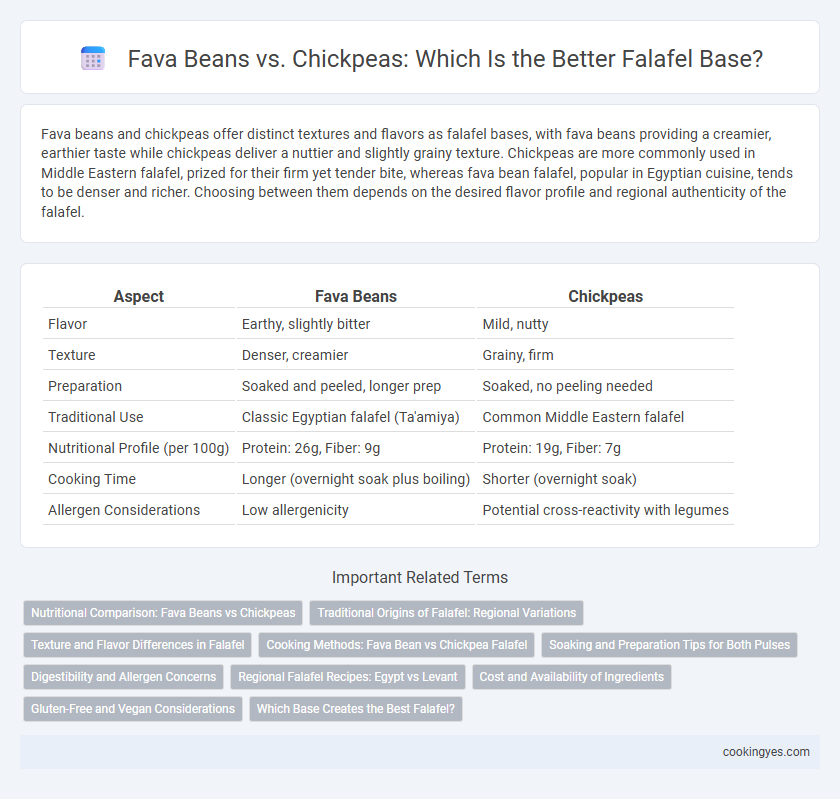Fava beans and chickpeas offer distinct textures and flavors as falafel bases, with fava beans providing a creamier, earthier taste while chickpeas deliver a nuttier and slightly grainy texture. Chickpeas are more commonly used in Middle Eastern falafel, prized for their firm yet tender bite, whereas fava bean falafel, popular in Egyptian cuisine, tends to be denser and richer. Choosing between them depends on the desired flavor profile and regional authenticity of the falafel.
Table of Comparison
| Aspect | Fava Beans | Chickpeas |
|---|---|---|
| Flavor | Earthy, slightly bitter | Mild, nutty |
| Texture | Denser, creamier | Grainy, firm |
| Preparation | Soaked and peeled, longer prep | Soaked, no peeling needed |
| Traditional Use | Classic Egyptian falafel (Ta'amiya) | Common Middle Eastern falafel |
| Nutritional Profile (per 100g) | Protein: 26g, Fiber: 9g | Protein: 19g, Fiber: 7g |
| Cooking Time | Longer (overnight soak plus boiling) | Shorter (overnight soak) |
| Allergen Considerations | Low allergenicity | Potential cross-reactivity with legumes |
Nutritional Comparison: Fava Beans vs Chickpeas
Fava beans contain higher protein levels, providing about 26 grams per 100 grams, compared to chickpeas' 19 grams, making them a robust protein source for falafel. Chickpeas offer more fiber, around 7.6 grams per 100 grams, which aids digestion and adds texture to falafel. Both legumes deliver essential vitamins and minerals, but fava beans have slightly more folate, while chickpeas supply more iron, influencing nutritional benefits depending on the base choice.
Traditional Origins of Falafel: Regional Variations
Traditional falafel recipes vary regionally, with Egyptian falafel predominantly using fava beans, known for their creamy texture and earthy flavor, while Levantine falafel favors chickpeas, prized for their nutty taste and denser consistency. Fava beans offer a softer, smoother falafel base that highlights Egyptian culinary heritage, whereas chickpeas provide the crispier, firmer texture associated with Levantine falafel traditions. These regional distinctions reflect the agricultural availability and cultural preferences influencing falafel's evolution across the Middle East.
Texture and Flavor Differences in Falafel
Falafel made with fava beans offers a creamier and denser texture compared to chickpea-based falafel, which tends to be lighter and crisper. Fava beans provide a slightly earthier and nuttier flavor, while chickpeas deliver a milder, subtly sweet taste that allows spices to stand out more prominently. The choice between these legumes influences the overall mouthfeel and flavor profile, with fava bean falafel often favored in Egyptian cuisine and chickpea falafel common in Levantine dishes.
Cooking Methods: Fava Bean vs Chickpea Falafel
Fava bean falafel requires soaking for 12-24 hours and benefits from boiling before grinding to ensure a smoother texture and ease of blending, while chickpea falafel is typically soaked overnight without cooking, preserving a coarser texture that crisps well during frying. Fava beans yield a creamier interior when boiled and blended, enhancing moisture retention, whereas raw soaked chickpeas produce a denser, grainier falafel with a firmer bite. Both methods affect frying time and oil absorption, with boiled fava bean falafel generally cooking faster and absorbing less oil than chickpea versions, optimizing texture and flavor.
Soaking and Preparation Tips for Both Pulses
Fava beans require a longer soaking time of 12-24 hours to soften properly before grinding, while chickpeas typically need 8-12 hours of soaking to achieve the ideal texture for falafel. Both pulses benefit from rinsing thoroughly and removing any skins to ensure a smoother falafel mixture. Soaking in cool water with a pinch of baking soda can help speed up the softening process and improve digestibility for either bean.
Digestibility and Allergen Concerns
Fava beans and chickpeas both serve as traditional bases for falafel, but chickpeas tend to be easier to digest for most individuals due to their lower oligosaccharide content, which reduces gas and bloating. Fava beans may trigger allergenic reactions more frequently, as they contain vicine and convicine compounds linked to favism in susceptible individuals, making chickpeas a safer option for those with legume allergies. Choosing chickpeas as the falafel base enhances digestibility and minimizes allergen risks while maintaining authentic flavor and texture.
Regional Falafel Recipes: Egypt vs Levant
Egyptian falafel, known as ta'amiya, traditionally uses fava beans as its base, offering a denser texture and earthier flavor unique to the region. Levantine falafel, popular in countries like Lebanon, Syria, and Israel, primarily employs chickpeas, resulting in a lighter, crispier falafel with a nuttier taste. These regional variations highlight local agricultural practices and cultural preferences, with fava beans thriving in Egypt's Nile Delta and chickpeas more common throughout the Levant, shaping authentic falafel recipes accordingly.
Cost and Availability of Ingredients
Fava beans tend to be more affordable and widely available in Mediterranean and Middle Eastern markets, making them a cost-effective base for traditional falafel. Chickpeas, while sometimes pricier depending on the region, are globally accessible through most grocery stores and often preferred for their creamy texture. The choice between fava beans and chickpeas largely depends on local ingredient costs and supply, impacting the overall budget for falafel preparation.
Gluten-Free and Vegan Considerations
Fava beans and chickpeas both serve as excellent gluten-free and vegan bases for falafel, with chickpeas offering a slightly nuttier flavor and a finer texture. Fava beans tend to yield a denser falafel, which can be preferred for a heartier bite and are equally rich in plant-based protein and fiber. Both legumes provide essential nutrients while adhering to strict gluten-free and vegan dietary requirements, making them versatile choices for diverse culinary preferences.
Which Base Creates the Best Falafel?
Fava beans and chickpeas each bring distinct textures and flavors as falafel bases, with chickpeas offering a nuttier, creamier profile while fava beans yield a denser, earthier bite. Chickpea-based falafel tends to produce a lighter, crispier outside and moist interior, favored in Middle Eastern cuisine for balanced taste and texture. Fava bean falafel is often preferred in Egyptian traditions, delivering a richer, more robust flavor that stands out in spiced blends.
Fava Beans vs Chickpeas for Falafel base Infographic

 cookingyes.com
cookingyes.com